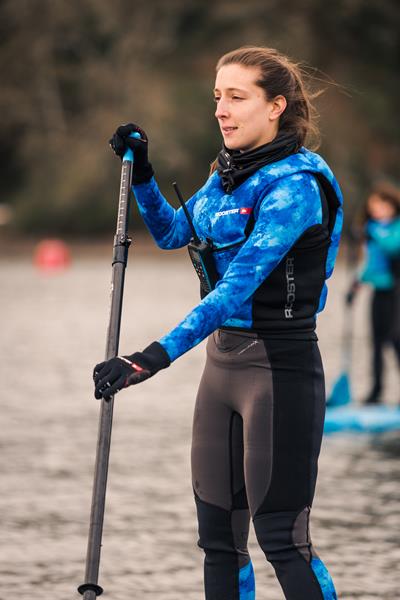Marine VHF Radio, an Important Safety Tool for Paddleboarders

It couldn’t have escaped you to notice the growing popularity of stand up paddleboarding. The cross between windsurfing and kayaking has been growing in popularity in recent years because of its simplicity and affordability with boards being used on lakes, rivers and around our coastline.
With more and more paddle boarders venturing further offshore, safety is now becoming a major issue. Here we talk about the benefits a simple marine VHF radio can provide a paddleboarder.
A marine VHF radio is an essential addition to your kit because it allows you to contact other radio users at sea. Should you encounter a problem, you can use the emergency channel (16) to call for assistance.
Radios are not just used for emergency situations. You can talk to other seafarers on one of your radios many other channels, or even let larger vessels nearby know where you are, just in case. You can also listen to routine weather forecasts and navigational warnings broadcast at 4-hourly intervals for all UK coastal areas!
So why shouldn’t a Paddleboarder use a mobile phone offshore?
In the first place, many paddlers venture some way from the coast. It is highly unlikely that there will be good mobile phone coverage away from the shoreline, particularly at sea level or below cliffs. A marine handheld VHF radio will give you great coverage and peace of mind, making it an essential piece of kit in offshore situations.
The mobile phone was not made for the harsh marine environment and was never intended to be used for maritime communication whereas the marine VHF radio was designed precisely for that purpose. They typically get wet and a phone does not float whereas with a marine VHF radio, you can drop your VHF radio into the water, pick it up and make a call.
Mobile phones don’t have marine frequencies, and you can only speak to one person at a time. When a marine radio transmits a message, all radio users listening within range will hear you! Another important point is that the Coastguard and the RNLI use marine VHF and are not equipped to pinpoint mobile phone transmissions.
So what radios are available for Paddleboarders?
ICOM have several marine VHF radio models available that all meet or exceed the basic level of IPX7 waterproofing. This means the radio can endure submersion in one metre of water for 30 minutes. ICOM recommend the new
IC-M25 buoyant VHF marine radio for paddleboarders because it is small, lightweight and buoyant. Not only does the LCD and key backlight on the front panel flash, but also the red LED light blinks through the rear panel showing the place of the radio so that it can be easily retrieved.
For those paddleboarders who want an extra piece of security there are handheld radios which incorporate a distress alert. Called DSC radios, they work just like a standard VHF handheld with a couple of additions. A DSC radio such as the
Icom IC-M94DE has a red emergency button on the back. By pressing and holding the button for 3 seconds, you can send an emergency distress signal to other vessels equipped with DSC radios as well as the Coastguard. If you have time, you can select the type of emergency from an on-screen list of options. The screen will confirm that the help message with your coordinates has been sent, and then automatically switch the radio to Channel 16, where rescuers will try to contact you by voice.
A user will require a Short-Range VHF licence to operate either of these radios, and there are many easy courses held at sea training schools and adult education centres across the country.
So, if you are serious about safety when paddleboarding, invest in a waterproof marine VHF radio, it could save your life!
Should you have any questions or want further advice about our range, contact our team at
sales@icomuk.co.uk or 01227 741741.
Picture courtesy of
www.georgefielding.co.uk.

